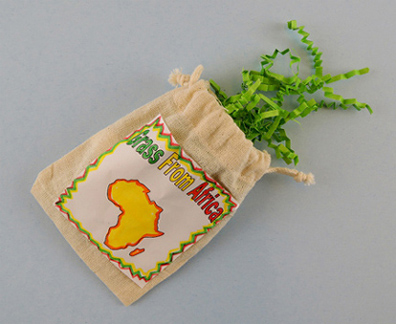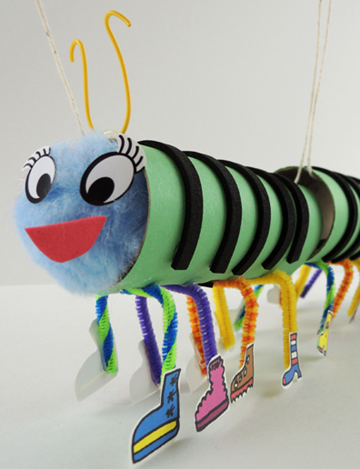 Sneakers, boots, bunny slippers, and galoshes. When you have 100 legs, you’re going to need a LOT of shoes. Good thing we have just the shoe store for you and your centipede marionette!
Sneakers, boots, bunny slippers, and galoshes. When you have 100 legs, you’re going to need a LOT of shoes. Good thing we have just the shoe store for you and your centipede marionette!
We read Centipede’s 100 Shoes by Tony Ross (Henry Holt, 2002). When little centipede stubs his toes, his mom tries to kiss it better…but exactly which toe is it? To avoid future stubbed toe incidents, little centipede and his mom head off to the shoe store. However, 100 shoes means 100 socks, 100 laces, 100 times putting shoes on, and 100 times taking shoes off. It’s just too much. So clever little centipede decides to forgo foot gear all together, distributing his shoes to friends with fewer leg hassles.
You’ll need:
- 3 toilet paper tubes
- Construction paper
- 4 pipe cleaners
- 1 centipede shoe template, printed on 8.5″ x 11″ card stock
- A length of curling ribbon (approximately 13″)
- A length of string (ours was approximately 4 ft)
- 1 wooden dowel
- Masking tape
- 1 jumbo pom-pom
- 1 set of eye stickers
- 1 snippet of twisteez wire or pipe cleaner
- Scissors and tape for construction
- Markers for decorating
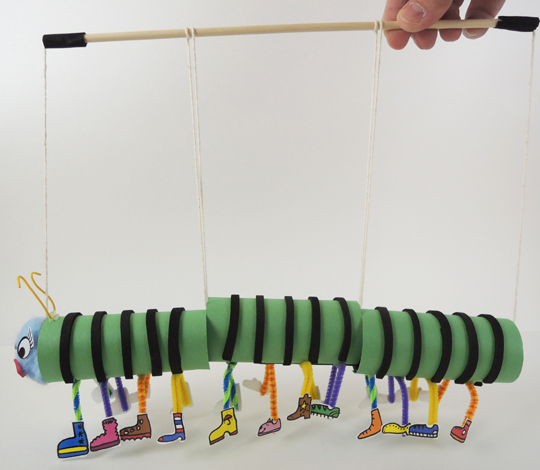
First, wrap 3 toilet paper tubes with construction paper. Use markers to add rings to the centipede’s body or bits of self-adhesive foam. Cut 4 pipe cleaners into 3rds, bend each piece into a U shape. At this point, you can add the shoes from the template to the ends of the legs, or your can do what we did and visit the centipede shoe store (which appears a little later in this post). Use tape to attach the legs to the undersides of the tubes.
Next, thread a 4″ piece of curling ribbon through the three tubes. Use tape to anchor the ribbon to the ends of the 1st and 3rd tube. This curling ribbon “spine” keeps the 3 tube segments of the marionette together, but also allows the centipede to be wiggly. You can see the green curling ribbon spine in the photo below:
 Katie came up with fantastic, easy method for stringing the marionette. Tie a 4 ft string to the end of a wooden dowel. Thread the string through the first tube, then loop it up and around the wooden dowel. Repeat this threading and looping through the second and third tubes, then tie the end of the string around the back end of the wooden dowel. Wrap the ends of the dowel in masking tape so the string doesn’t slide off. You can see the string loops in the photo below:
Katie came up with fantastic, easy method for stringing the marionette. Tie a 4 ft string to the end of a wooden dowel. Thread the string through the first tube, then loop it up and around the wooden dowel. Repeat this threading and looping through the second and third tubes, then tie the end of the string around the back end of the wooden dowel. Wrap the ends of the dowel in masking tape so the string doesn’t slide off. You can see the string loops in the photo below:
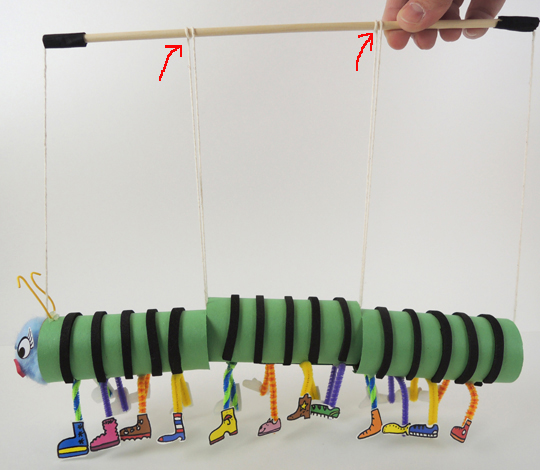 Last but not least, your centipede’s face. You don’t want to put the face on BEFORE you thread the marionette string, because the pom-pom will be blocking the end of the tube! the face is a jumbo pom-pom (which we hot glued in place), eye stickers, a self-adhesive foam smile, and twisteez wire antennae.
Last but not least, your centipede’s face. You don’t want to put the face on BEFORE you thread the marionette string, because the pom-pom will be blocking the end of the tube! the face is a jumbo pom-pom (which we hot glued in place), eye stickers, a self-adhesive foam smile, and twisteez wire antennae.
Earlier, I mentioned that you can put the centipede’s shoes on when first create the pipe cleaner legs. But we delayed that step so the kids could take their marionettes shopping at the Lots and Lots of Shoes store, which I created using a box lid!
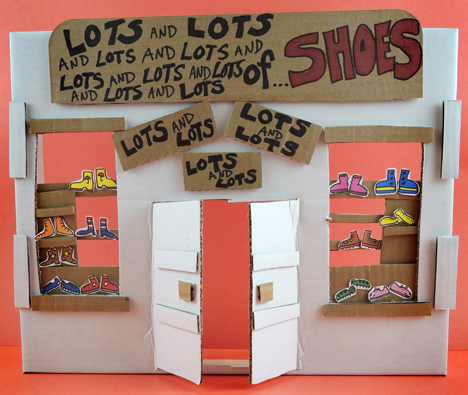 The kids walked over with their centipedes, and I slid the shoe templates through the front door of the shop.
The kids walked over with their centipedes, and I slid the shoe templates through the front door of the shop.
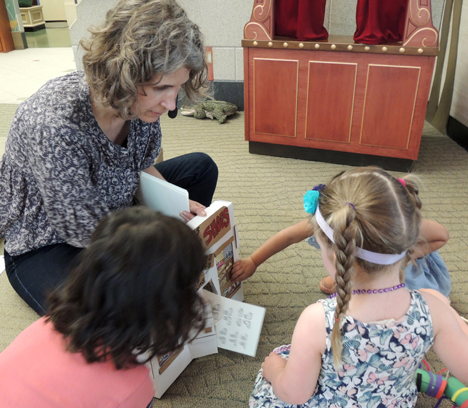 The shoes were then colored, cut, and taped the centipede’s legs. Admittedly, this marionette can be a little floppy while it’s getting its shoes attached. Which brings me to this clever technique a parent came up with:
The shoes were then colored, cut, and taped the centipede’s legs. Admittedly, this marionette can be a little floppy while it’s getting its shoes attached. Which brings me to this clever technique a parent came up with:
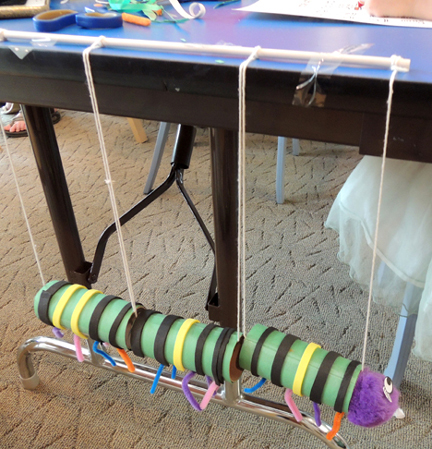 Tape the dowel to the table, and you are free to attach the shoes on a dangling marionette with minimal flopping. ABSOLUTELY BRILLIANT!
Tape the dowel to the table, and you are free to attach the shoes on a dangling marionette with minimal flopping. ABSOLUTELY BRILLIANT!

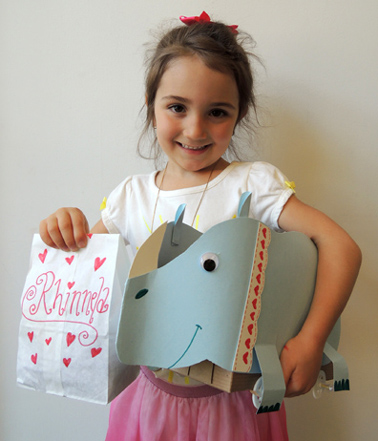 Want a pet rhino? Of course you do! But pet ownership is a tremendous responsibility. Get prepared with a customized accessory bag that contains a water dish, rhino snacks, and a cozy fleece blanket.
Want a pet rhino? Of course you do! But pet ownership is a tremendous responsibility. Get prepared with a customized accessory bag that contains a water dish, rhino snacks, and a cozy fleece blanket. You can also use cardboard wheels or skip the wheels entirely and simply slide the box across the floor. Now for the rest of the rhino! Fold a large, 7.5″ x 28″ piece of light blue poster board in half. Cut the rhino body from the template, then place the nose of the rhino template against the fold in the poster board. Cut the template out of the poster board, leaving the nose fold intact.
You can also use cardboard wheels or skip the wheels entirely and simply slide the box across the floor. Now for the rest of the rhino! Fold a large, 7.5″ x 28″ piece of light blue poster board in half. Cut the rhino body from the template, then place the nose of the rhino template against the fold in the poster board. Cut the template out of the poster board, leaving the nose fold intact.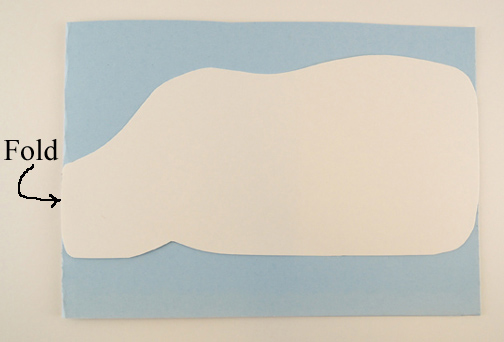 Cut a rhino horn out of white poster board and hot glue it inside the fold. Hot glue 1″ of the entire front of the fold together as well. This gives your rhino the appropriate muzzle shape. Tape or glue the rhino body to the box, making sure the leave about 1″ of space between the rhino body and the bottom of the box.
Cut a rhino horn out of white poster board and hot glue it inside the fold. Hot glue 1″ of the entire front of the fold together as well. This gives your rhino the appropriate muzzle shape. Tape or glue the rhino body to the box, making sure the leave about 1″ of space between the rhino body and the bottom of the box.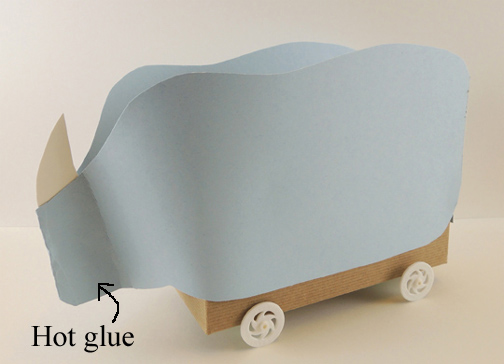 Cut a piece of light blue poster board to fit the back section of the box. Round the top of it and tape or hot glue it to the box. This is your rhino’s rump. Again, leave about 1″ of space between the rhino body and the bottom of the box. And don’t forget to add a tail!
Cut a piece of light blue poster board to fit the back section of the box. Round the top of it and tape or hot glue it to the box. This is your rhino’s rump. Again, leave about 1″ of space between the rhino body and the bottom of the box. And don’t forget to add a tail!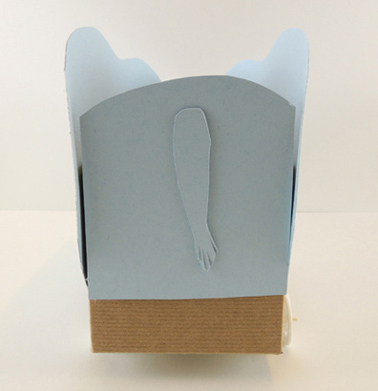
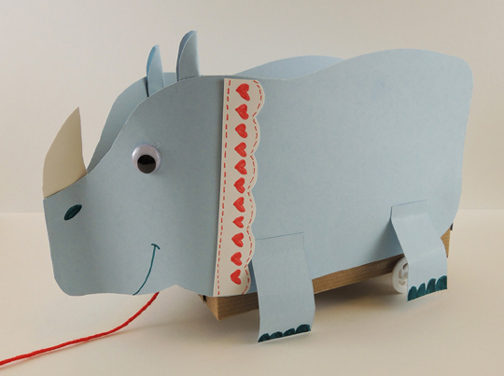
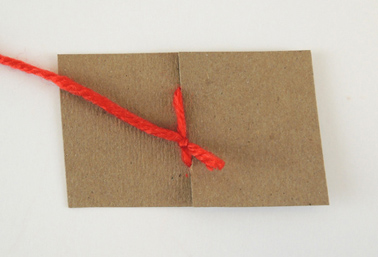 Attach the leash assembly to the front of the box (under the rhino’s the “chin”). Keep the assembly towards the bottom of the box. If it’s up too high, your rhino will keep tipping over.
Attach the leash assembly to the front of the box (under the rhino’s the “chin”). Keep the assembly towards the bottom of the box. If it’s up too high, your rhino will keep tipping over.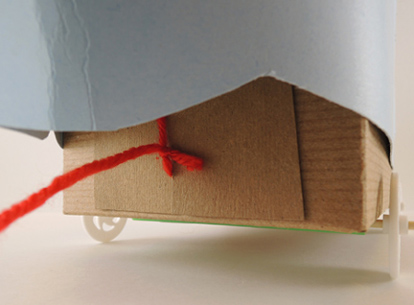 That’s it for the rhino, now for your accessories! Our paper accessory bags held a water dish, a bag of African grass, and a fleece blanket (we offered a choice of pink, blue, or purple).
That’s it for the rhino, now for your accessories! Our paper accessory bags held a water dish, a bag of African grass, and a fleece blanket (we offered a choice of pink, blue, or purple).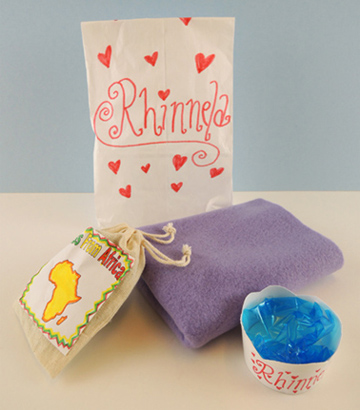 The water dish was a shortened paper cup with blue cellophane taped to it. In the book, Rita’s rhino eats African grass, so we hot glued labels to the front of a small drawstring bag (left over from
The water dish was a shortened paper cup with blue cellophane taped to it. In the book, Rita’s rhino eats African grass, so we hot glued labels to the front of a small drawstring bag (left over from 